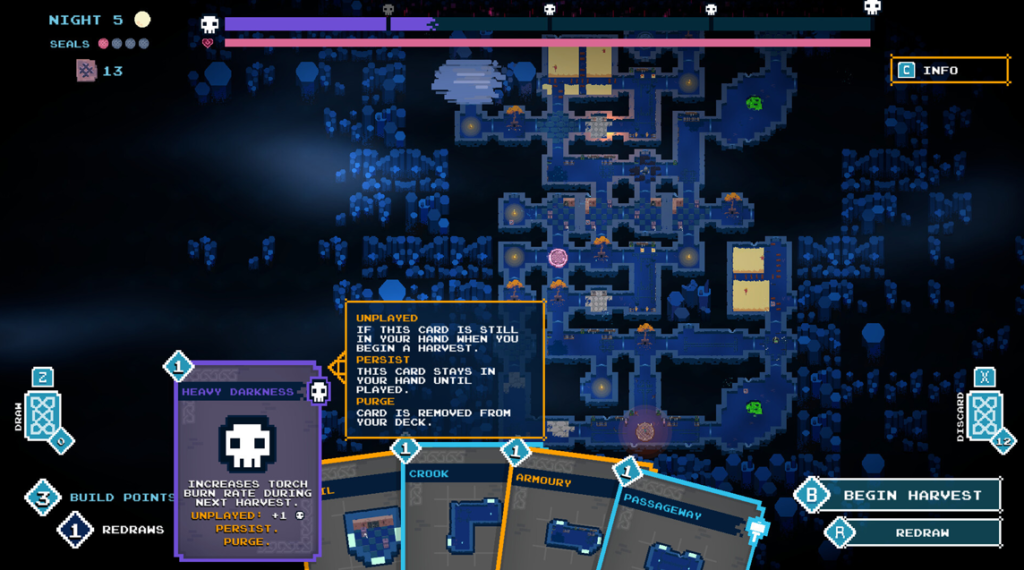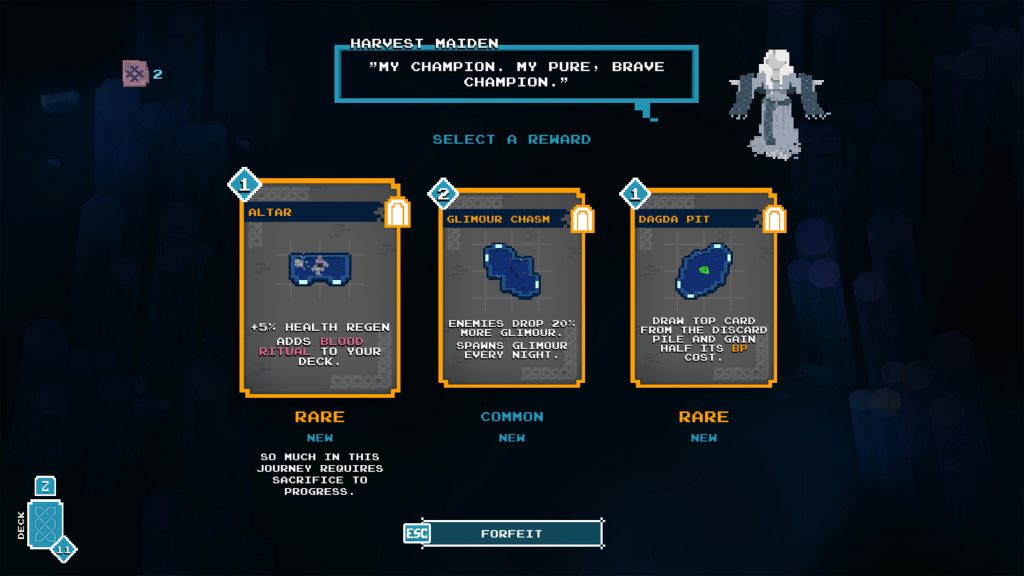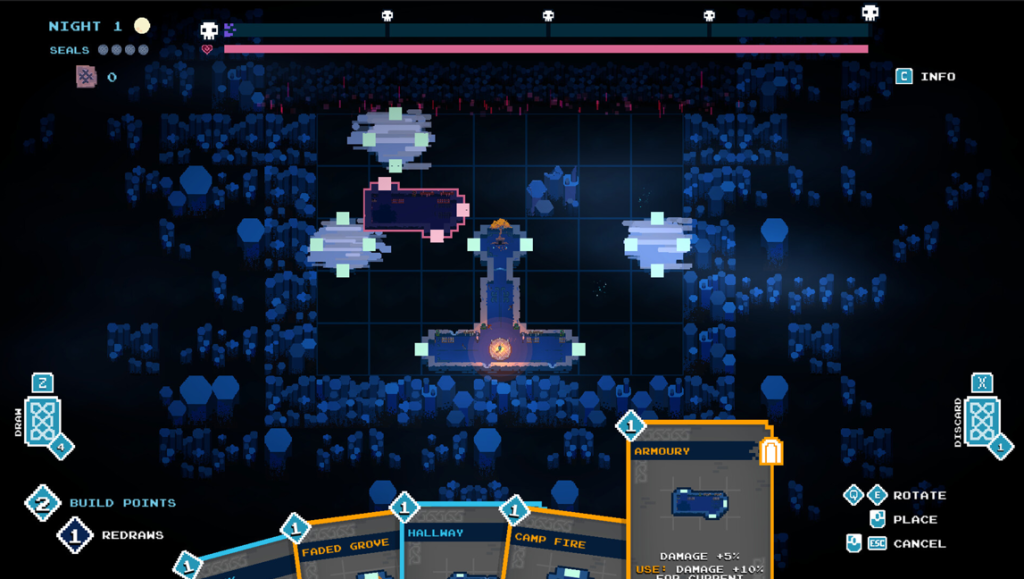A Unique Fusion of Genres and Folklore
Into the Restless Ruins, developed by Ant Workshop and published by Wales Interactive, is a roguelike deckbuilder that immediately sets itself apart by blending dungeon building, deck construction, and auto battler mechanics, all steeped in the eerie atmosphere of Scottish folklore. Available on PlayStation 5, Xbox Series X|S, Nintendo Switch, and PC, the game invites players to not just traverse dungeons, but to design them, card by card, shaping both their path and their fate with every decision.
The game opens in Eorisdale, a misty, foreboding region that serves as your introduction to the mechanics and lore. Here, you meet memorable NPCs like the Hen Wife and the Wulver, who offer critical upgrades and card enhancements. The folklore influence is palpable, from the boss battles against figures like The Grey Man (Am Fear Liath Mòr) to the presence of the Harvest Maiden, who promises to grant your deepest desires in exchange for toil and risk.

Deckbuilding Meets Dungeon Crafting
What truly distinguishes Into the Restless Ruins is its dynamic deck and dungeon building system. Each card in your deck represents a room or corridor, and you’re tasked with constructing a sprawling, interconnected dungeon before embarking on your run. The strategic depth here is immense: every card placement affects the dungeon’s layout, with rooms varying in shape, entrance points, and effects. Some rooms buff your stats, others offer resources or temporary boosts, and the most powerful rooms like armories and forges often come with awkward shapes that complicate your path and force creative navigation.
This mechanic is both a blessing and a challenge. On one hand, it offers a refreshing sense of agency and replayability; on the other, it demands careful planning, as a poorly designed dungeon can make your journey back to the escape portal a true test of memory and resource management. You cannot consult your map after entering the dungeon, so remembering your own layout becomes part of the core challenge, especially as your creation grows more labyrinthine.
Technical Depth: Cards, Relics, and Progression
The technical breadth of Into the Restless Ruins is impressive. The game features:
- 116 unique cards across 7 categories, each with distinct effects and shapes
- 6 different ruins to explore, each with its own set of challenges and bosses
- 62 enemy types, including 6 formidable bosses inspired by Scottish legends
- 40 passive charms to tailor your strategy
- 38 Cantrips that modify gameplay and increase rewards
- 12 weapons to unlock and master, each with their own combat style and synergies.
Meta progression is robust, with relics and card synergies unlocking as you delve deeper. Each run offers new modifiers, hidden echoes, and opportunities to expand your card pool, ensuring that no two journeys through the ruins are ever quite the same.
Atmosphere and Presentation
Visually, the game leans into retro pixel art, with a top down perspective during dungeon construction and a zoomed in view for exploration and combat. The 8 bit soundtrack and sound effects contribute to a haunting, immersive atmosphere that perfectly complements the game’s Celtic themes. The user interface is clean and functional, with three colored bars representing health, energy, and torchlight each a vital resource to manage as you descend deeper into darkness.
The torch mechanic is particularly noteworthy: it constantly drains as you explore, forcing you to strategically place rooms that replenish light and to carefully pace your exploration. This adds a subtle layer of time pressure and resource management that keeps the tension high throughout each run.

Gameplay Loop: Innovation and Frustration
The core gameplay loop is deceptively simple: draw five cards, spend energy to place rooms, then raid the dungeon you’ve built. After clearing the dungeon, you must race back to the escape portal before starting anew. This loop is endlessly addictive, with each decision where to branch off, when to place a torch room, how to connect awkwardly shaped rooms having lasting consequences on your run.
However, as much as I appreciate the innovation in dungeon building, the combat side of things left me wanting more. The auto battler mechanics mean that encounters with enemies and even bosses often feel underwhelming. Weapons and enemy behaviors are relatively simple, and I rarely felt truly threatened, even during boss fights. This lack of combat depth makes the game feel a bit too easy if you play cautiously, and I found myself wishing for more tactical complexity in these moments.
Personal Experience: The Genius and the Grind
What kept me hooked was the sheer novelty of building my own path forward. The constant push and pull between creating a dungeon that’s both rewarding and traversable is a stroke of genius. The obstacles both environmental and structural force you to confront the consequences of your decisions in a way that feels genuinely fresh. There’s a certain satisfaction in navigating a maze of your own design, even as you curse the awkward shapes and branching paths that make your return trip a memorization challenge.
Yet, this same genius can become a grind. As dungeons grow larger, backtracking can feel tedious, and the inability to consult your map mid run adds a layer of frustration that may not appeal to everyone. Still, the pixel art and music provide a comforting backdrop, making each run feel atmospheric and inviting, even when the gameplay stumbles.
Replayability and Community Building
Into the Restless Ruins offers nearly endless replayability thanks to its procedurally generated dungeons, evolving card pool, and the variety of strategic options unlocked through charms, cantrips, and relics. The game’s deep roots in Scottish folklore and its commitment to community evident in its inclusion of Scottish Gaelic language support and its array of memorable NPCs make it feel like a living, breathing world that rewards exploration and experimentation.
From a customer success perspective, I see great potential in how the developers can continue to build on this foundation, engaging the community with new content, balance updates, and perhaps more challenging combat scenarios in future patches or expansions.

Conclusion
Into the Restless Ruins stands out as a bold, innovative entry in the roguelike deckbuilder genre. Its unique blend of dungeon construction, strategic card play, and atmospheric presentation creates a gameplay experience that feels both fresh and deeply satisfying at least on the strategic and creative fronts. While the combat may lack the depth and tension some players crave, the game’s core loop of building, exploring, and adapting is compelling enough to keep me coming back for more.
For anyone seeking a roguelike that truly lets you shape your own journey, Into the Restless Ruins is a must try. Its flaws are real, but so is its genius, and I suspect that sense of novelty and discovery will linger long after the credits roll. Whether you’re a fan of folklore, deckbuilders, or simply looking for something new, this is a dungeon worth getting lost in.